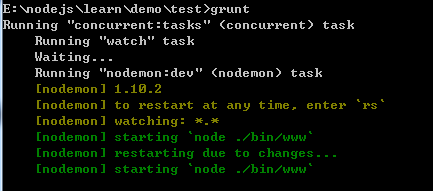Grunt可以执行像压缩, 编译, 单元测试, 代码检查以及打包发布的任务。
本文介绍使用Grunt实现nodejs程序自启动功能。
目录:
- Grunt介绍
- Grunt安装
- Grunt使用
- Grunt常用加载任务的插件:
1)grunt-contrib-watch
2)grunt-nodemon
3)grunt-concurrent
1.Grunt介绍
Grunt是一个自动化的项目构建工具. 如果你需要重复的执行像压缩, 编译, 单元测试, 代码检查以及打包发布的任务. 那么你可以使用Grunt来处理这些任务, 你所需要做的只是配置好Grunt, 这样能很大程度的简化你的工作.
如果在团队中使用Grunt, 你只需要与其他人员约定好使用Grunt应该规避的问题, 就能够很方便的自动化的处理大部分的常见工作任务, 你所付出的努力几乎为0.
1.Grunt安装
我目录下的文件(使用express -e test新建的一个项目)

Grunt和Grunt插件都是通过npm, Node.js包管理器安装和管理的
我的系统环境:
- win7 64bit
- nodejs:6.3.1
- npm:3.10.3

本地安装grunt

后面加上 --save-dev,可以直接把grunt作为devDependencies写入的package.json中
安装完grunt后,还需要安装一个grunt插件:grunt-cli,为什么需要grunt-cli这个模块,有了grunt-cli,你可以在项目的任意子目录中运行grunt 。

grunt-cli的工作原理:每次运行grunt 时,他就利用node提供的require()系统查找本地安装的 Grunt。正是由于这一机制,你可以在项目的任意子目录中运行grunt 。如果找到一份本地安装的 Grunt,CLI就将其加载,并传递Gruntfile中的配置信息,然后执行你所指定的任务。
grunt-cli需要全局安装的原因:当执行grunt命令时,会默认先去全局的grunt-cli下找grunt-cli模块,而不会先走当前目录下的node_modules的grunt-cli
此时执行grunt,会报如下错误:

实际上grunt运行,依赖package.json和Gruntfile.js两个文件,项目初始化时,已经生成了package.json文件,这里还缺少Gruntfile.js文件
新建Gruntfile.js文件:

再次运行grunt:

没有报错,但是提示默认的任务没有找到,这是因为我们在Gruntfile.js文件中没有添加任务,包括默认任务。
gurnt的自启动实现,需要三个加载任务的插件:
他们的安装方式如下:
npm install grunt-contrib-watch --save-dev npm install grunt-nodemon --save-dev npm install grunt-concurrent --save-dev
安装完的package.js文件如下:
{ "name": "test", "version": "0.0.0", "private": true, "scripts": { "start": "node ./bin/www" }, "dependencies": { "body-parser": "~1.15.1", "cookie-parser": "~1.4.3", "debug": "~2.2.0", "ejs": "~2.4.1", "express": "~4.13.4", "morgan": "~1.7.0", "serve-favicon": "~2.3.0" }, "devDependencies": { "grunt": "^1.0.1", "grunt-concurrent": "^2.3.1", "grunt-contrib-watch": "^1.0.0", "grunt-nodemon": "^0.4.2" } }
grunt、grunt-concurrent、grunt-contrib-watch、grunt-nodemon模块名分别存放在devDependencies下。
grunt-concurrent:针对慢任务的插件,优化慢任务
grunt-contrib-watch:可以监控特定的文件,在添加文件、修改文件、或者删除文件的时候自动执行自定义的任务,比如 livereload 等等
grunt-nodemon:实时监听入口文件(app.js),入口文件出现改动,就会自动重启
下面来编写Gruntfilr.js文件
module.exports = function(grunt){ grunt.initConfig({ watch:{ ejs:{ files:['views/*'], options:{ livereload:true } }, js:{ files:['public/javascripts/*'], // tasks:['jshint'], options:{ livereload:true } } }, nodemon:{ dev:{ options:{ file:'app.js', args:[], ignoredFiles:['node_modules/**','DS_store'], watchedExtensions:['js'], watchedFolders:['./'], debug:true, delayTime:1, env:{ PORT:3000 }, cwd:__dirname } } }, concurrent:{ tasks:['nodemon','watch'], options:{ logConcurrentOutput:true } } }); grunt.loadNpmTasks('grunt-contrib-watch'); //只要有文件修改,增加删除,就会重新执行 grunt.loadNpmTasks('grunt-nodemon'); //实时监听入口文件(app.js),入口文件出现改动,就会自动重启 grunt.loadNpmTasks('grunt-concurrent'); //针对慢任务的插件,优化慢任务 grunt.option('force',true); grunt.registerTask('default',['concurrent']); }
上述livereload:true,表示监听的文件被修改以后,自动刷新页面。
再次运行grunt:

启动成功!!!!
打开app.js文件,随便敲几个空格并保存之后,看到控制台有如下变化:
